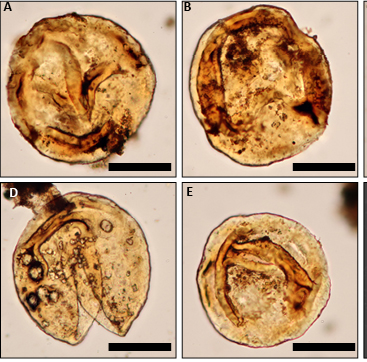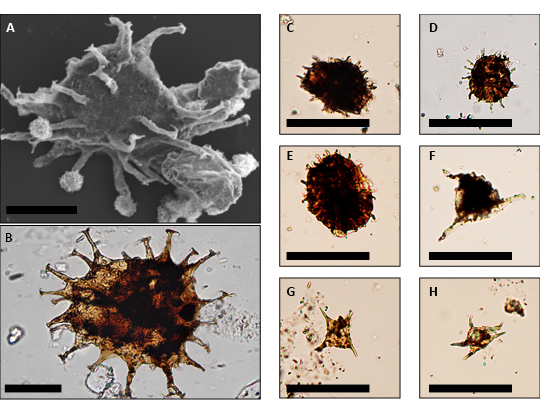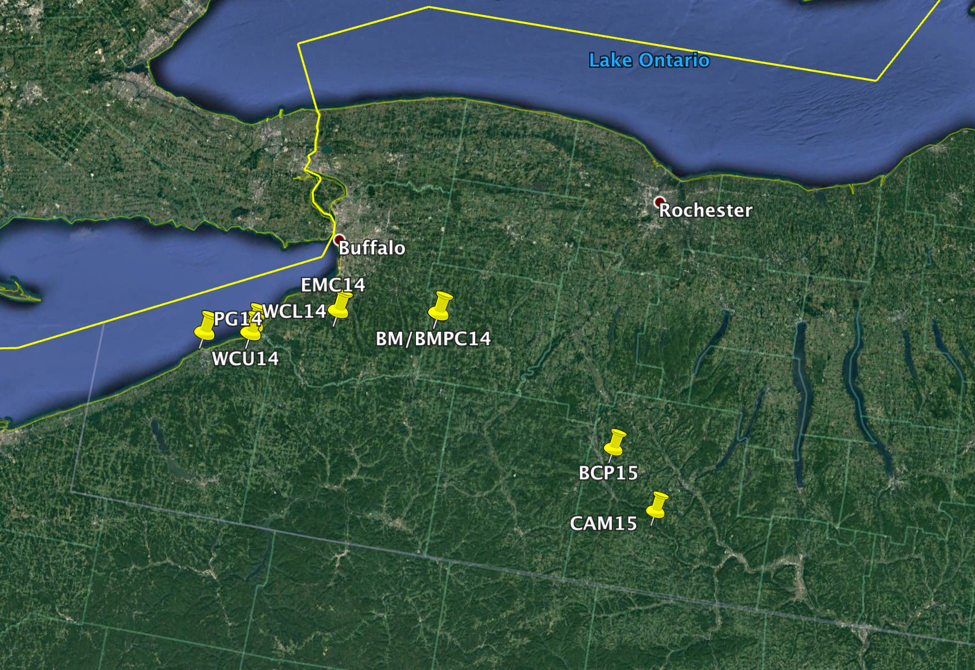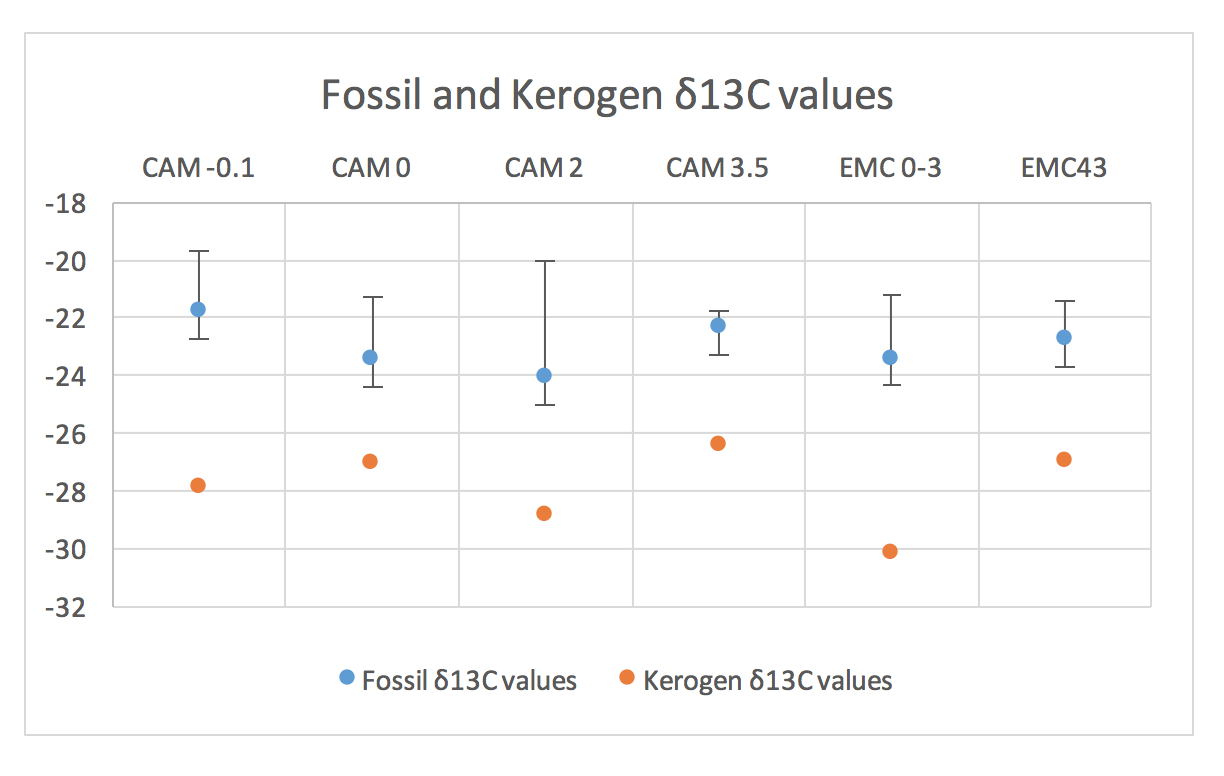Reports: UR856967-UR8: Building a High Resolution Record of Organic-Walled Microfossils in Upper Devonian Shales: Paleoenvironmental and Ecological Implications
Phoebe Cohen, Williams College
The Late Devonian was a time of highly elevated biodiversity loss, turnover, and ecological restructuring. The largest pulse of Late Devonian extinctions occurs at the Frasnian-Fammenian (F-F) boundary. The causes of the F-F extinctions are poorly understood and remain a topic of some controversy, but it is widely believed that low oxygen conditions played a role. Although an extinction in the marine invertebrate fossil record is well documented, less research has been done to understand the record of organic-walled microfossils (OWMs) both in terms of their diversity and their paleoenvironmental significance in light of data suggesting lowered oxygen levels during these intervals. Organic-walled microfossils (OWMs) are microscopic, close-walled fossils made of recalcitrant organic material (Figs 1 and 2). They likely represent structures made by a variety of eukaryotic organisms including algae and animals. Many OWM forms are poorly understood. We often do not know what kinds of organisms made these structures, why they form them, or how preservational processes affects their diversity and abundance in the fossil record. Despite these issues, OWMs are often used to interpret patterns in deep time such as overall biological diversity and marine primary productivity.
Figure 1. Organic-walled microfossils from late Devonian strata of Upstate New York. Examples of smooth-walled forms found in both deep and shallow water sections. Scale bars are 50 microns. Fossils from section BCP15 representing the Lower Kellwasser horizon.
Figure 2. Organic-walled microfossils from late Devonian strata of Upstate New York. Examples of spiny forms only found in shallower water sections. Scale bars are 50 microns. Fossils from section BCP15 representing the Lower Kellwasser horizon.
We have discovered that organic-walled microfossils are abundant before, during, and after the F-F extinction event in strata exposed in Western New York (Figs 1-3). These events are captured in organic-rich black shale horizons known as the Kellwasser Events. OWM represent an underutilized window into our understanding of the Late Devonian biodiversity crisis. Our initial results show that there are abundant microfossils present across both the lower and upper Kellwasser horizons in multiple localities in Western Upstate New York. The abundance and morphology of OWMs changes on a stratigraphic scale small enough to capture a meaningful signal across the Kellwasser events. For example, we have discovered that fossil abundance increases in rocks that are within the Kellwasser events relative to those before and after, even after fossil abundance is scaled to the total organic carbon (TOC) present in the rocks (Fig. 4). In addition, morphological variation is present throughout the events and between sections as well, most notably variation between deeper and shallower water localities in an east-west transect across the state (Figs 1 and 2). Finally, we have measured the carbon isotopic composition of an initial set of rock and OWM samples from our localities and have shown that there is a significant offset between OWM and coeval kerogen, perhaps indicating that OWMs were algal in origin and providing information about the strength of the late Devonian biological pump (Fig. 5).
Figure 3. Map of localities sampled so far.
Figure 4. Absolute fossil abundance from section WCU14. The shaded grey area indicates strata equivalent to the Upper Kellwasser black shale horizons; the beginning of the Kellwasser horizon was measured as 0 cm. Counts of fossil abundance were scaled to total organic carbon (TOC) of the host rock to determine absolute abundance of fossils per mg of host rock.
Figure 4 shows that fossil abundance increases in the beds of the Upper Kellwasser event relative to sediments before and after, even after total organic carbon content is taken into account. This suggests that the absolute abundance of OWMs is increasing during these events and that the signal is not simply due to increased carbon preservation. This increase in fossil abundance could be due to an increase in biological productivity resulting in more biomass, or it could be due to an increase in the formation of recalcitrant cysts (OWMs) by organisms in response to environmental stress. Further research will help to distinguish between these two possibilities.
In collaboration with Chris Junium at Syracuse University, my thesis student Ezekiel King Phillips spent the summer working on the carbon isotopic composition of our OWM samples to better determine their paleoecology and help to reconstruct paleoenvironmental conditions during the extinction interval. These samples were run using Environmental Analyzer-Isotopic Ratio Mass Spectometry system (EA-IRMS). The δ13C values of individual microfossils were variable between fossils and significantly different from coeval kerogens (Fig. 5). The offset potentially indicates a strong biological pump wherein the fossils represent a surface (planktonic) signal and the kerogen represents a mixed signal from both shallow and deeper settings. If export from the surface to deeper settings is high, kerogen sources from deeper waters will have a lighter, more negative δ13C value because it is sourcing its carbon from a lighter pool derived from re-mineralized light organic carbon. In contrast, surface carbon, represented here by the fossil values, will reflect a photosynthetic fractionation offset from atmospheric carbon values.
Figure 5. Kerogen and fossils δ13C data from two stratigraphic sections; CAM is the Lower Kellwasser event and EMC is the Upper Kellwasser event. Both show an offset between fossil δ13C and kerogen δ13C. See text for an explanation of the values.
Thus far this project has opened up new collaborations and moved my research in a new direction. This has been instrumental for my career development as it has allowed me to become a broader researcher. My research students have had the opportunity to present their original research at conferences, and have gained skills in data collection, analysis, microscopy, and more. I have involved first year students as well as older students in this project, and have created opportunities for students to mentor each other and learn from each other during the research process. One of the first students involved in this work is now starting a graduate program in Paleontology at the University of Cincinnati. I look forward to continuing this project and involving students in authentic research experiences.
















